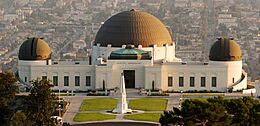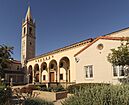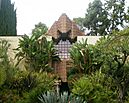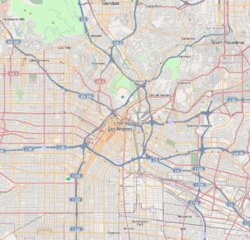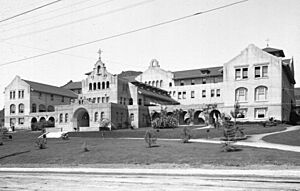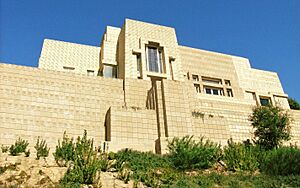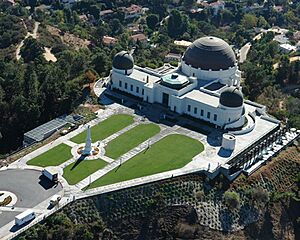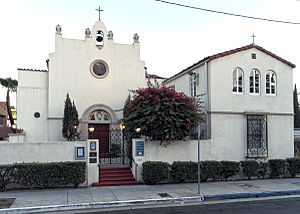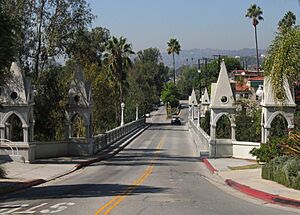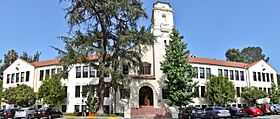Los Feliz, Los Angeles facts for kids
Quick facts for kids
Los Feliz
|
|
|---|---|
|
Top: Abraham Gore House (left), Vista Theatre (right); middle: Griffith Observatory; bottom: Church of Christ, Scientist (left), Sowden House (right).
|
|
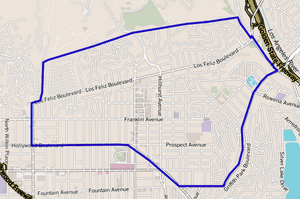
Los Feliz neighborhood, as mapped by the Los Angeles Times
|
|
| Country | |
| State | |
| County | Los Angeles |
| City | Los Angeles |
| Named for | Rancho Los Feliz |
| Elevation | 469 ft (143 m) |
| Time zone | UTC-8 (PST) |
| • Summer (DST) | UTC-7 (PDT) |
| Zip codes |
90027
|
| Area code(s) | 213, 323 |
Los Feliz (pronounced "Lohs FEE-lis") is a cool neighborhood in Los Angeles, California. It's on a hillside near Hollywood and even includes parts of the Santa Monica Mountains. The name "Los Feliz" comes from the Feliz family. They owned this land way back in 1795! That's when José Vicente Féliz was given a big piece of land called Rancho Los Feliz.
Contents
History of Los Feliz
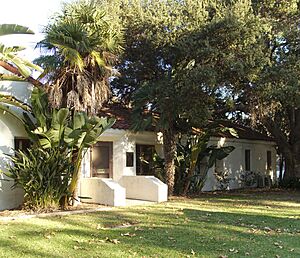
Early Inhabitants: Native Americans
Long before Spanish settlers arrived, Native Americans lived here. It's thought that the first people came to this area about 10,000 years ago. They built villages all over the land. One village was right where Los Feliz is today.
Scientists have found signs of a large village in Fern Dell Canyon, inside Griffith Park. The people who lived there were called Tongva. This name was given to them by the Spanish.
Spanish and Mexican Eras
In 1769, an explorer named Gaspar de Portolà traveled through this area. He met people from the Native American village.
The land, which was about 6,647 acres (27 square kilometers), was given to Corporal José Vicente Feliz. This was one of the first land grants in California. An old adobe house built in the 1830s by his family still stands in Griffith Park. Other parts of this land became the communities of Los Feliz and Silver Lake.
After America Took Over
After America took control of California, the Rancho Los Feliz land had new owners. The Feliz family first sold it to Antonio F. Coronel. Then it went to James Lick. His family later sold it to Griffith J. Griffith.
Griffith gave more than half of the land to the city of Los Angeles. This huge area became Griffith Park, one of the biggest city parks in the country. In 1882, Colonel Griffith bought 4,071 acres (16.5 square kilometers) of the rancho. The Lick family still owned the southwest part, which later became part of Hollywood. Griffith was called "Colonel" as an honorary title, not because he served in the military.
Modern Times in Los Feliz
In 1900, Los Feliz was very small, with only 23 properties. Griffith died on July 6, 1919, when he was 67. He left $700,000 and his Los Feliz land to the city. This money and land were used to make Griffith Park even bigger.
In May 2007, a large wildfire burned about 800 acres (3.2 square kilometers) in Los Feliz and Griffith Park. This included a famous spot called Dante's View. After the fire, city officials promised millions of dollars to fix the damage.
Geography of Los Feliz
Los Feliz has several smaller, unique areas within it. These include the Los Feliz Hills, Los Feliz Estates, Laughlin Park, Los Feliz Village, Los Feliz Square, Los Feliz Knolls, and Franklin Hills.
According to the Los Angeles Times, Los Feliz is in central Los Angeles. It is next to Griffith Park to the north. To the northeast is Atwater Village. Silver Lake is to the southeast. East Hollywood is to the south. Hollywood and Hollywood Hills are to the northwest.
Los Feliz is close to major highways like the 101 and the 5. The neighborhood has a hot-summer Mediterranean climate. This means it has warm, dry summers and mild, wet winters.
People of Los Feliz
In 2000, about 35,238 people lived in Los Feliz. The neighborhood is about 2.61 square miles (6.76 square kilometers). This means it has a lot of people living in a small area. By 2008, the population grew to about 36,933. The average age of residents was 36, which is a bit older than the rest of the city.
Los Feliz is a very diverse neighborhood. In 2000, about 57.6% of residents were white. About 18.7% were Latino, and 13.5% were Asian. Many people (44.5%) were born outside the U.S. The most common birthplaces were Armenia (25.3%) and Mexico (9.4%).
The average household income in 2008 was about $50,793. Most people (75.5%) rented their homes or apartments. The average household size was two people.
Communities in Los Feliz
The Los Feliz Neighborhood Council divides the area into five main parts:
- District A: Los Feliz Hills and Los Feliz Estates
- District B: Los Feliz Square, Laughlin Park, and Thai Town North
- District C: Los Feliz Village
- District D: Los Feliz Knolls and Waverly Heights
- District E: Franklin Hills and some nearby blocks
The Oaks is a hilly area on the west side of Los Feliz. It is part of the Hollywood United Neighborhood Council. However, it is also within the Los Feliz Improvement Association.
Los Feliz Hills
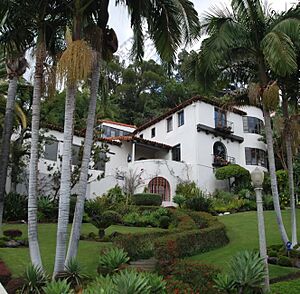
The area north of Los Feliz Boulevard, below Griffith Park, is called the Los Feliz Hills. This area has very expensive homes. Many people who work in creative jobs live here. The average household income is about $196,585.
The Los Feliz Heights area was first developed in 1921. It stretched from Los Feliz Boulevard north to Griffith Park. Many homes here were built between 1920 and 1949. They show different styles like Spanish Colonial and Tudor.
Laughlin Park
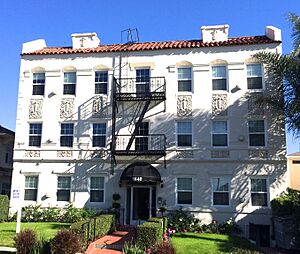
Laughlin Park is a special community with 60 houses. It is a gated community, meaning it has controlled entrances. A famous actor named W.C. Fields once lived here in a large house built in 1919.
Los Feliz Village
Los Feliz Village is the southern part of Los Feliz. This is where most of the shops and businesses are. It is mainly along Vermont and Hillhurst Avenues. You can find coffee shops, restaurants, and small clothing stores here.
The Los Feliz Village Business Improvement District helps local businesses. They also hold a fun street fair every year. In 2014, a funny shop called Dumb Starbucks opened here. It was a parody of Starbucks for a TV show.
Schools in Los Feliz
In 2000, about 42% of adults in Los Feliz had a four-year college degree. This is a high number for the city.
Here are some of the schools in Los Feliz:
- John Marshall Senior High School: This public high school opened in 1931. It was designed in a special style called Collegiate Gothic. After an earthquake in 1971, some buildings needed repairs. The main building was saved and reopened in 1981. The school's football stadium was also updated in 2010.
- Franklin Avenue Elementary School
- Los Feliz Elementary School
- Thomas Starr King Middle School
- Our Mother of Good Counsel: A private elementary school.
- Lycée International de Los Angeles: A private elementary school with a campus in Los Feliz.
Some families in Laughlin Park often choose to send their children to private schools like Lycée International or the Oaks School. The Immaculate Heart school is also very close to the community.
See also
 In Spanish: Los Feliz (Los Ángeles) para niños
In Spanish: Los Feliz (Los Ángeles) para niños




